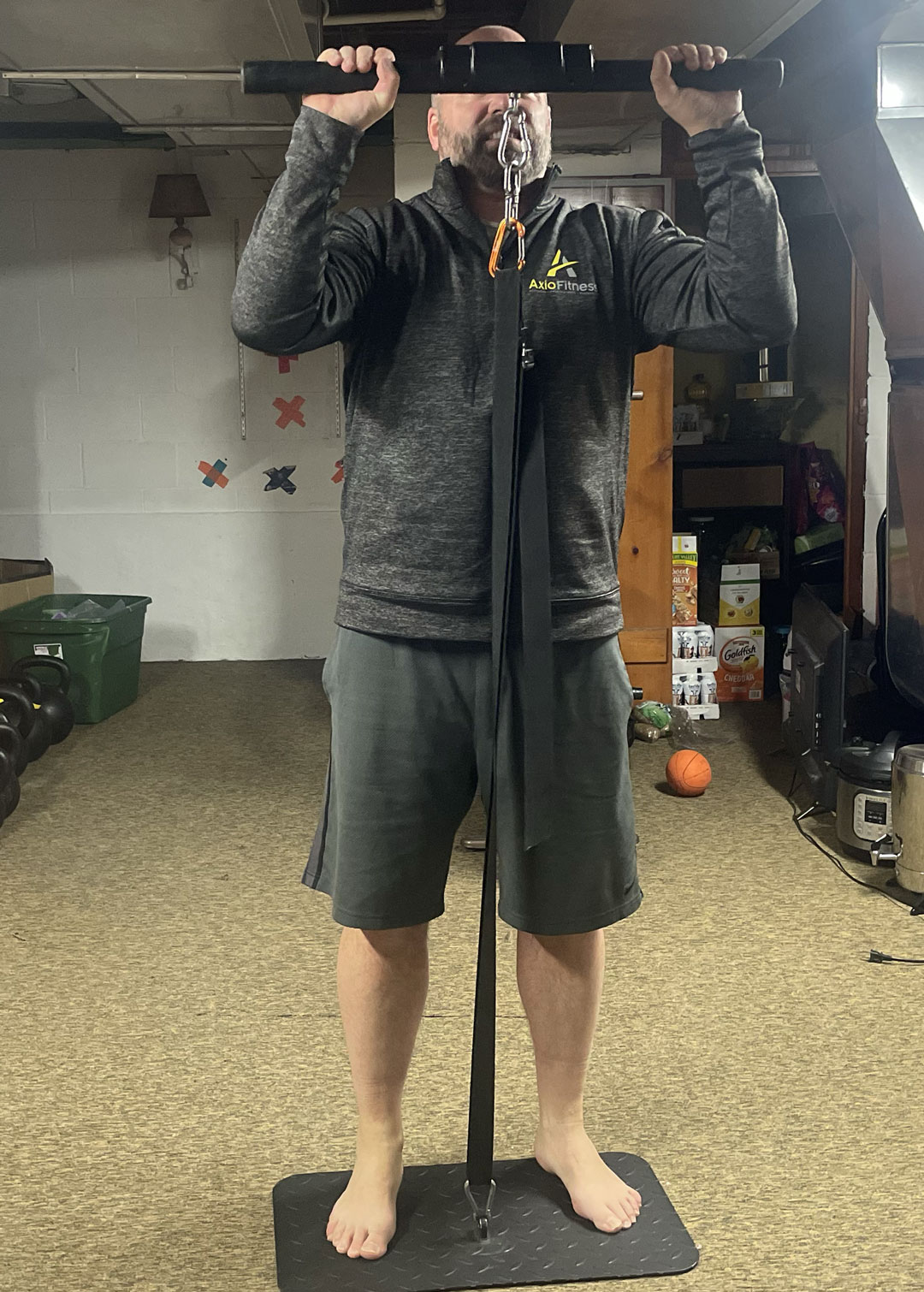If I walked past you in a store, you wouldn’t know that I am an avid IsoChainer. I look like a rather ordinary middle-aged man who struggles to eat a consistently balanced diet and who may dabble in the weight room.
And yet, I believe all the hype that I’ve read about isometrics and specifically the
IsoChain. I believe it because it is clear, logical and backed up by scientific evidence. The number of articles over the last years on this site alone have persuaded and equipped me, not to mention Paul Wade’s excellent
The Ultimate Isometric Manual as well as Matt Schifferle’s and Chrys Johnson’s fantastic respective Youtube channels.
Further, I believe because I’ve used myself as an experiment for the last two years by using the
IsoChain almost exclusively. And here are the results:
- I move better.
- I wake up with no stiffness in my lower back.
- My blood pressure is lower.
- My biceps, triceps, and lats (if I had to rank the most noticeable areas of improvement) are larger and firmer.
- I’ve had fewer motivationally-dry seasons to get myself down in my basement to lift because I love the instant and precise feedback that the IsoChain gives me.
In other words, I’m an Iso-junkie and I am not ashamed.
I’m not the guy people ask for barbell lifting advice. There are lots of guys I know who fairly deserve to be the go-to’s for that kind of thing. They spend many hours a week in the gym.
That’s not my jam. I have two jobs and a busy family of a wife and four children. I struggle to keep my normal habits of reading and prayer and quality time with my fantastic wife and children. So, I’m very happy to quietly make incremental improvements to my strength, body composition and much more by getting to the
IsoChain just 3-4 times a week for 20-40 minutes each time.
I believe the everyday person can get behind this kind of investment into isometrics. So when I meet someone who I think may be more open minded to real science and real life results, I’m very happy to talk freely, point them to all the resources I listed above and then share a few of my own tidbits.
After two years of fairly consistent use, here are some small nuggets of information that may be helpful to add to the boulders you’ve already learned about isometrics and the
IsoChain.
One: There is no such thing as a perfect ‘rep’
I don’t remember where, but I have heard it said about the kettlebell swing — there is no such thing as a perfect swing. Whether I didn’t squeeze the quads or lats or I didn’t flex the knees the right amount, there is always something to reflect upon and improve with each swing, each set, each session.
To be a math nerd for a second, the kettlebell swing should be like an asymptote — always getting near the axis point but never actually arriving to touch that line. We chase improvement to get closer and closer to perfection even if we know that it will never arrive. Thus, we keep working. And I’ve come to see that each isometric rep is the same way.
Paul Wade has said it here many times — each rep, no matter the body part targeted, is a full body engagement. So I often reflect on the reps and sets I’ve done and think "I should have engaged my core more" or "I should have corkscrewed my feet into the ground more". I ask myself "Did I give that last set the full body tension — focusing especially on the antagonist muscle I’m working as well as my core, quads, hind and feet?"
I don’t get defeated by this process. Instead, I use it to excite me for the next session where I could squeeze upward by a few more pounds or a few more seconds. This is the most influential discovery (by reading and my own practice) I’ve made about using the
IsoChain so far.
By realizing this, I’ve gathered small tidbits along the way to help. Sometimes I know that I just wasn’t mentally prepared or "into" the workout. One of the reasons I don’t listen to music while working out on the
IsoChain is that I need full mental engagement and music distracts (everyone’s different; this is just me). If I am to give myself to full body tension then I need to give my mind to it as well.

Two: Know your parameters
As I mentioned above, lots of accomplished people have written about isometrics. They know a lot. They are reasonable. Listen to them. And yet, as many of them have said, don’t limit yourself to the protocols they recommend and exercises they use. In other words, heed to the advice of the experts but don't be completely tethered to them.
Perhaps this is too simplistic but I’ll still give it a go — the only parameters on your isometrics work are safety on one side and creativity on the other.
Paul Wade has said on this site many times to not be afraid to change things up. So, if someone said to try a protocol for six weeks and you know your numbers are plateauing after four, change your approach.
The Ultimate Isometrics Manual has loads of protocols. With angle and exercise variation included, there are enough protocols to last me the rest of my life. Still, I wrote my own protocol when I needed a specific type of program after a hernia surgery late last year.
After my warmup sets, I did a set of 20 seconds, rested 45 seconds and then a set of 6 seconds of the same exercise. And it has worked great for what I needed during that time. I also tried three new exercises that I hadn’t seen anywhere in the Manual or videos — a leg extension, a chest press, and a lat exercise.
All the while, as Dan John often says, when things are going well, don’t be afraid NOT to change things up. My point is that creativity may show itself in thinking outside the box by keeping with the same program or doing the exact protocol listed by a coach. Or, it could mean that you are willing to try something that no one has tried and see what happens.
And this leads to my third and final nugget that could help you.
Three: The value of community
So much of what I’ve passed on has been given to me, or at least spurred on, by the community of IsoChainers in the private Isochain Isometrics Users group on Facebook. Just by checking in a few times a week, I get ideas, refinement and even pushback on my own thinking (and practice) from hundreds of other like-minded people around the world.
Once in a while I read a post there about someone not wanting to buy the
IsoChain but making a DIY one instead. I’m totally sympathetic to the issue of money and financial constraints each of us have in our life’s circumstances. But I do wonder how well one will progress without the feedback — audio and numeric — that is exclusive to the IsoChain. In parallel, I don’t know how much one could progress and enjoy the IsoChain and isometrics without the feedback and interaction of the group. I’ve learned both components are vital to my progress and enjoyment of the workout.
There you go. A few ideas from an ordinary guy to spur you on and perhaps get you thinking above and beyond what we already know about the practice of isometrics. And if things go well, you’ll be able to share back with a bunch of us new ways to grow and spread the vision.
 Marty Sweeney
Marty Sweeney is Global Content Director for Matthias Media and Executive Director for Matthias Media USA. He also serves as Pastor for Training at Old North Church in Canfield, OH. He and his wife, Abby, live in Northeast Ohio with their four children.